Reviews
Die xue jie tou
John Woo
Hong Kong, 1990
Credits
Review by Rumsey Taylor
Posted on 26 July 2012
Source Bootleg VHS
Categories John Woo’s Hong Kong
John Woo’s brand of hyperkinetic action crime movies may be divided into two periods, the second of which - beginning with 1993’s Hard Target - has secured his reputation as an action director with Western audiences. In many of the films hence, Woo has entertained aesthetic preoccupations with elaborately choreographed action setpieces, generous slow motion, and scores upon scores upon scores of bullets that result in comprehensive destruction. The latter is the only necessary distinction in Woo’s filmmaking; his films display some variety in plotting, chronology, and geography, but they’re fundamentally all armories in which a pair of semi-automatic weapons - one for each hand - is persistently within reach.
Many of Woo’s American films are suitable demonstrations of his hyperkinetic aesthetic, 1997’s Face/Off in particular, in which Woo’s proclivity towards excess is most clearly manifested. But in this current era of Woo’s career, the excesses - although ensuring some of the most thrilling scenes of his career thus far - betray the skin-of-your-teeth resourcefulness of his earlier films. Woo’s first era culminated with 1992’s Hard Boiled, a confidently- realized crime movie, but also a humorous one, that takes place entirely in contemporary Hong Kong. The same more or less applies to Hard Boiled’s precedent, The Killer, and the first two A Better Tomorrow films. These four films example Woo’s most exercised and consistent filmmaking, and this is due in no small part to Chow Yun-Fat as the charismatic lead in each film—on the video cover for each, he’s typically seen armed with two pistols aimed in the same direction.
It was at this point that Woo first reached great acclaim both in his native Hong Kong and abroad. (Shortly hereafter his first English-language film - the Jean-Claude Van Damme vehicle, Hard Target - would fail to fully encompass his aesthetic preferences; Woo’s original cut of the film was truncated by over twenty minutes.) And it is here, nested in between his celebrated Asian action movies and his American emigration, that we find Bullet in the Head. In composition it features Woo’s trademarks in action choreography and interest in platonic allegiance: the numerous shootouts amount to the majority of the film’s total running time, and each of these is expectedly chaotic. But when considered among the films to which it is chronologically proximate, Bullet in the Head emerges as somewhat anomalous within Woo’s pre-Hollywood output. Whereas The Killer and Hard Boiled featured a comparative narrowness in scope and especially politics, Bullet in the Head is considerably more expansive—it occurs in a past era (it opens in 1967, and concludes three years later) and its title credits lack Chow Yun-Fat’s reliable nameplate1. An early scene features a civil protest in the background, iconified by a single individual who stands incredulously in front of a tank in the middle of the street. This sequence, a re-enactment of the Tiananmen Square protests a year prior to the film’s release, is but one of many allusions to factual hostilities.
Bullet in the Head reaches so forcefully past the modest narrative reach of Woo’s other action movies that what ultimately impresses you is its wild endeavoring to amount to something epic. It’s as elaborate as you’d expect, replete with emphatic camerawork and editing, but the characters aren’t the one-liner toting, inherently expendable breed of henchman ordinarily pelted by bullets in Woo’s other films. The settings don’t favor the requisite abandoned warehouse rendez-vous. Despite the numerous, near archetypical instances of Woo’s brand of action, Bullet in the Head is characterized by its bleeding heart ambition.
The film comprises four years in the lives of four friends and the disintegration of their allegiance in the midst of the Vietnam War. This allegiance is always at the fore, and the periphery finds the war, protests, or the criminal frameworks that persist—either in Hong Kong, where the film opens, or in Saigon. In no other Woo film at the time is the setting or era as central and established as it is here. The friends emigrate to Saigon after a crime in Hong Kong leaves them wanted, and for a moment they enjoy the success of their efforts—in an early, standout sequence they enter a crimelord’s mansion, and, after deftly earning his trust, dispense with dozens upon dozens of bodyguards and policemen. They mow down the periphery with a rain of bullets, exiting with consummate poise. In any other Woo film this would be the beginning of their success as a crime faction.
Woo has regularly exampled a tendency for homage, perhaps best demonstrated in The Killer, which sustains the basic plot and scene sequence of Le Samouraï. The homage is less explicit in Bullet in the Head, but there are clear allusions to The Deer Hunter (which also follows a group of friends into the toils of war), Apocalypse Now (in the characters’ descent into the heart of Vietnam—by boat, even), Full Metal Jacket, and Days of Being Wild. The clearest template, however, is The Good, the Bad and the Ugly, which analogizes the desperate, do-or-die greed of the main characters with the peripheral, non-fictionalized war, and to some extent the same applies to Bullet in the Head. One could say that the action set pieces are less directorially indulgent in this film because of the context - the chaos is imaginably more appropriate in a war - but at the same time they’re just as wild and chaotic as in Woo’s other films from the era.
Woo handles the expansive narrative with confidence, but his grip on the context is never firmly authorial. Only in the aforementioned shootout, which occurs entirely in a mansion, does he really seem at ease with the material. The others - one on a riverbed, another in a small village - are chaotic for the sake of being chaotic—it’s John Woo cut and pasted into an unusual context. This chaos should only be appreciated, however, because Woo is without peer in this regard. Rest assured, a shootout in a John Woo movie will never be conservative by any measure—they’re sometimes narratively arbitrary interludes that adhere only to their own rhythm, and even without context are frenzied to the point of kaleidoscopic abstraction. As these shootouts make up much of the bulk of Bullet in the Head, the result is a somewhat disjointed film, one whose investment in political and platonic affiliation is betrayed by its cartoonish action sequences. But this incongruity endears the film. It is nonetheless astonishing, not in its scope but rather in its determination. This, for better or worse, is John Woo’s single epic.
- Bullet in the Head is by some accounts an offshoot of the termination of Woo’s partnership with producer Tsui Hark. The two had collaborated on A Better Tomorrow and its sequel, but Woo was not attached to the subsequent installment, A Better Tomorrow III. His script for the film was the basis for Bullet in the Head, and his regular muse, Chow Yun-Fat, would reprise his role in the A Better Tomorrow series. ↩
More John Woo’s Hong Kong
-
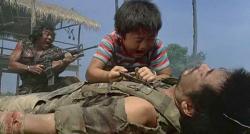
Heroes Shed No Tears
1986 -
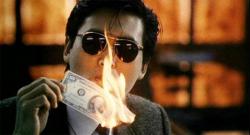
A Better Tomorrow
1986 -
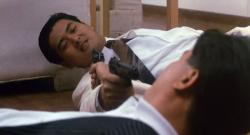
The Killer
1989 -
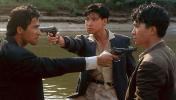
Bullet in the Head
1990 -
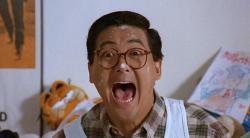
Once a Thief
1991 -
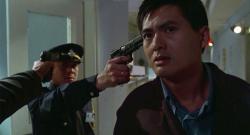
Hard Boiled
1992
We don’t do comments anymore, but you may contact us here or find us on Twitter or Facebook.



